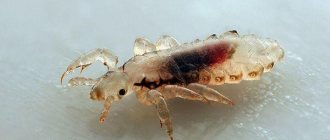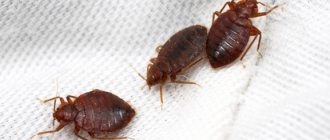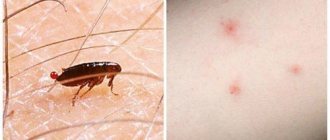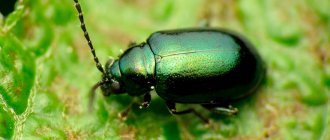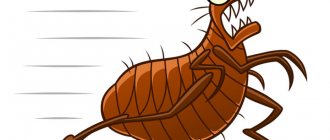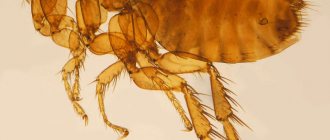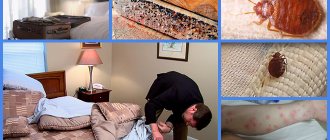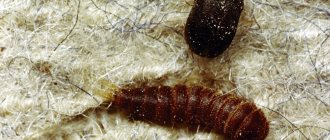- Who are we dealing with?
- Why do fleas appear in bed?
- How to detect linen fleas
- Are bed fleas dangerous?
- How not to deal with bed fleas?
- Two safe ways to eradicate insects from a bed Method 1. Temperature treatment of the bed
- Method 2. Folk remedies
Fleas can smell blood from a kilometer away. It is enough for one adult to jump onto a pet’s fur or into an open door, and within two weeks the home will be infested with annoying parasites. They settle in baseboards, carpets, bedding and even in the bedroom. So, you found fleas in your bed - how to get rid of these insects?
Who are we dealing with?
Researchers managed to describe 2086 species and 15 families of fleas. The name “bed flea” was coined by people who encountered insects in the bedroom. From a scientific point of view, this type of insect does not exist. The parasite that has settled in the bed belongs to the family of common fleas.
The insect is covered with a durable chitinous shell that cannot be damaged by simple pressure. The body is flattened laterally. The bristles and spines covering the limbs allow the flea to cling to the fur and skin of the victim. Thanks to their long hind legs and a special traction mechanism, fleas make high-speed and high jumps.
Parasites love to lay eggs not only on the pet’s fur, but also in secluded corners of the apartment. Larvae and pupae are distinguished by their vitality. They feed on decomposed organic matter (particles of dust and debris).
Bed linen and mattress care
To reduce the risk of parasite reproduction, special attention should be paid to the sleeping area - there is a large accumulation of bed fleas due to the availability of food. It is important to periodically clean the mattress cover, vacuum the bed, and change bed linen regularly.
If disinsection has been carried out previously, all laundry must be washed at high temperatures. There may have been flea excrement, larvae, or dead adults in the laundry. Washing is necessary to prevent bed fleas or allergic reactions.
Why do fleas appear in bed?
First, the insect enters the home. For this, an intermediate link is needed.
- Pets walking outside;
- Basements;
- Human clothing and footwear;
- Neighbor's apartment;
- Open doors and windows in hot weather.
The parasite then finds a place suitable for living, feeding and reproducing. There are three reasons why fleas are attracted to human beds.
- Food source. A sleeping person practically does not react to bites. He lies quietly in bed, so the bed flea calmly drinks blood.
- Favorable place for laying eggs. Insects usually choose fleecy surfaces for such purposes. First, the eggs reliably stick to the bed linen and mattress, and then the resulting larvae and pupae feed on particles of the epidermis.
- Safety. During cleaning, a person carefully vacuums carpets, washes floors and baseboards, and wipes away dust. But he forgets to shake the mattress and clean the inside of the bed frame. Fleas calmly continue to live and reproduce.
Parasites love stale, damp bedding, garbage and dust under the bed.
Precautions when getting rid of fleas
When dealing with domestic parasites, it is necessary to strictly adhere to precautionary measures. This will help optimize work and reduce the risks of negative consequences. By ignoring strict rules, you can cause enormous harm to your body, as well as expose your loved ones, especially children and pets, to the risk of infection.
Personal safety measures
If you are planning independent actions to combat insects, you need to pay attention to the following aspects:
- take care of protective clothing. This is especially true for chemical control methods. It is necessary to have gloves, a respirator, shoes and clothing made of thick fabrics or polyethylene;
- provide for the presence of a vacuum cleaner, broom, iron, brush, rag, bags, etc. This is necessary so that during the work everything is at hand, since leaving the room or searching for the right thing will be inconvenient;
- make sure there is adequate ventilation. This is especially necessary after chemical treatment. You should immediately check how easily the windows and doors open.
- Chemical processing agents are highly flammable. It is recommended to keep this in mind and avoid open flames. When using electrical appliances, it is necessary to check the serviceability of sockets and wires to avoid sparks.
General safety measures when there are children and animals
Particular attention should be paid to the points below if you have children and pets. Elderly people also need help and need to be taken care of:
- Decide on the choice of means. To do this, you need to familiarize yourself with the necessary information and instructions for use. It is recommended to pay attention to the timing of the procedure and assess the situation. You will have to leave the premises for some time, so you should take care in advance about who will be there and where. You may have to set up a crib and pet house in another room, since chemical disinfection takes a long time.
- At the end of processing and keeping for a certain time, it is necessary to thoroughly ventilate the room. Even if there is a slight odor, the return to the premises should be cancelled. Children's bodies and animals' bodies are particularly sensitive to toxic substances.
- Thoroughly treat with a soapy solution and soda those places that the child will come into contact with or that the animal can reach.
- When using the powder, you must make sure that neither a child nor a pet can get it.
- If there are any unspent funds left for disinfestation, they must be hidden in places inaccessible to children and animals.
Video: flea trap
How to detect linen fleas
Sometimes people confuse bed fleas with other parasites (lice, bedbugs), and mosquitoes are blamed for the bites. You can detect harmful insects in the bed by the following signs.
- Small black dots on bed linen and mattress in the form of commas. This is flea excrement.
- Dark brown color of larvae. Unfortunately, it is almost impossible to notice pest eggs on bedding.
- Visual appearance of an insect. The length of the flea's body is a maximum of 5 millimeters, the color is dark brown or black. The insect jumps with such lightning speed that it creates a feeling of magical disappearance.
Preventing fleas
Prevention will help prevent an unpleasant neighborhood and protect yourself and your pets from pest invasion.
Compliance with the following rules will eliminate the appearance of insects:
- Maintain cleanliness in the linen closet at all times.
- Regularly treat carpets and upholstered furniture.
- Ventilate and dry pillows, blankets, and mattresses in the fresh air.
- Use high temperatures to wash and iron clothes.
- Dry-clean your outerwear periodically.
- Choose a flea collar for pets.
- When cleaning premises, do not miss hard-to-reach places.
- Avoid accumulation of garbage in the apartment.
By adhering to these rules, you can protect yourself and your home from bed fleas and other blood-sucking pests.
Are bed fleas dangerous?
Bed flea bites are painful. These parasites lack anesthetic enzymes, unlike other insects (lice, bedbugs, ticks). Nature has already endowed fleas with protective mechanisms: speed, agility, and a hard shell. Therefore, they do not have to hide and disguise themselves. If a person is bitten by a flea, he still won’t have time to kill the culprit.
During a bite, the parasite secretes a substance that prevents blood clotting. This allows him to get enough of it. Red spots with a black dot in the center and a pink halo form at the site of the bite. The wounds itch and heal painfully.
In children and some people, bed flea bites cause allergic reactions. In rare cases, the lymphatic system is affected, which leads to numerous inflammations on the skin.
Bed fleas are carriers of worms and dangerous diseases, including the following.
- Typhus;
- Encephalitis;
- Hepatitis B;
- Hepatitis C;
- Plague;
- Tuberculosis;
- Brucellosis.
Chemicals
The most popular option for getting rid of insects is the use of chemicals. When carrying out pest control yourself, you should use a special respirator and rubber gloves. Such precautions will help avoid inhalation of harmful substances and skin contact with the chemical.
To combat bed fleas, almost any substance that is designed to exterminate crawling insects is suitable. The most popular is Dichlorvos. But there are other drugs that differ in cost, toxicity, and application features.
What remedies will help you get rid of harmful parasites:
- Delta Zone - active ingredient - Deltamethrin. Allows you to get rid of not only fleas, but also cockroaches, flies, bedbugs, mosquitoes, and ants.
- Xulate Micro - active ingredients of the drug - PPB, Tetramethrin, Cypermethrin. Used in the fight against fleas, bedbugs, cockroaches.
- GET – active substance – Chlorpyrifos. Fights fleas, as well as cockroaches, bedbugs, ants and flies.
- Adamant – active substances – Malathion, Cypermethrin. Allows you to get rid of wingless insects such as fleas, bed bugs, ants.
Treatment with toxic drugs should be carried out in the absence of children and animals. It is better to put food products in the refrigerator or tightly closed cabinet so that the substance does not get on them.
Beds are treated with the selected preparation, especially in joints and crevices. You need to spray the product on the baseboards, cabinets, and clothes. The drug must be distributed, moving towards the exit. You should pay attention to the bathroom during the spraying process, as insects accumulate in damp rooms. The apartment must be left with the windows and doors closed for several hours.
After carrying out the treatment, after some time it is recommended to repeat the procedure - new fleas may hatch from the eggs that were previously laid by insects, then the previously carried out action will not bring results. It is better to postpone cleaning for several days; there is no need to wash the treated walls and floors of chemicals, this way the treatment will be more effective. It is recommended to wash bed linen, pet beds, and mattress covers at high temperatures.
If necessary, you can contact special SES services. They carry out disinfestation using special equipment; after the event, there is less chance that parasites will reappear.
How not to deal with bed fleas?
There are many insecticidal products sold in stores: aerosols, solutions, powders. You can find articles on the Internet about how to remove bed fleas using chemicals. However, the authors' recommendations are wrong.
After treatment, the insecticides will penetrate the mattress. As a result, it will become dangerous for a person to sleep on the bed due to possible contact of toxic substances with the skin and respiratory organs. Aerosols and concentrates are suitable for treating the apartment as a whole, and not for killing bed fleas. More cunning methods are needed.
Tips for choosing a disinfection service
The most reliable method of getting rid of bed fleas is the help of a professional disinfection service.
Specialists will quickly deal with parasites. This will save time and eliminate the need for contact with insecticides.
When choosing a disinfection service, you should pay attention to:
- The drugs used by the organization must be safe for humans and animals.
- The time for the procedure is chosen by the customer, not the company.
- The service clients are explained in detail the disinfection process, the chemicals used, and safety measures.
- Conscientious organizations work without prepayment.
- If the cleaning is unsuccessful, the customer does not pay for this event.
Services whose employees care about their reputation provide quality services, after which they receive only positive reviews.
Two safe ways to get insects out of your bed
How to get rid of fleas in bed without getting hurt yourself?
Method 1. Temperature treatment of the bed
Bed fleas hate two extremes: frost and heat. If it’s severe winter outside, open the windows in the bedroom and leave it like that for 2-3 hours. Not only the adults, but also the larvae will die out, leaving you to thoroughly vacuum the bed.
High temperatures will also help against fleas. Boil the bed linen and treat the mattress with a steam generator.
The bed body should be thoroughly cleaned of dust and washed with soap.
Method 2. Folk remedies
Bed fleas hate strong plant odors. Throw old bedding in the wash. Treat the mattress with 10 drops of any of the following essential oils:
- Eucalyptus,
- Tea tree,
- Pine,
- Fir,
- Lavender,
- Geranium,
- Mint,
- Anise.
Place dry twigs of wormwood or tansy in the bedroom. Fresh plants can be placed in a vase on the bedside table. Sleep for 2-3 days in another room. After that, go back to the bedroom and vacuum the mattress and under the bed. Do a general wet cleaning.
Please note that treating the bed for fleas alone is not enough. Perhaps some of the adult insects will move to other rooms and hide in carpets and baseboards. Therefore, the next step is to completely remove fleas from the apartment.
Getting rid of fleas on pets
Pets suffer from annoying flea bites even more than their owners. The parasites overwhelm the helpless animal, which is unable to get rid of them on its own. If even one insect remains on the fur, there will be no peace for all the inhabitants of the house. Shampoos, sprays, drops and collars are used to fight. Each product has its pros and cons, so before use you should consult a veterinarian, read information on the Internet, and also study the instructions:
- shampoo will help get rid of annoying fleas in one session. It is necessary to carefully read the instructions and monitor your pet’s behavior after using the drug. The process requires an individual approach, since the product can cause allergies in the animal. The downside is the lack of protection from relapse. If there is an external flea source, the insect may settle on the fur soon after washing. Therefore, it is recommended to “take baths” once a month in the summer, and once every three months in the winter;
Shampoos instantly relieve pets of fleas, but there is a possibility of recurrence - The spray kills fleas the first time. After treatment, you can not be afraid of a relapse for a long time, since parasites are afraid of a specific smell and sense it from a distance. The difficulty is in applying the product to the surface of the skin. Firstly, animals do not like such procedures. Secondly, the product can cause allergies or nervous disorders in your pet. Therefore, it is recommended to carefully read the contraindications in the instructions and pay attention to the behavior of the animal. If your pet reacts negatively to the product, you should choose another method;
Most often, sprays are applied to the animal’s withers, where it cannot reach with its tongue. - a collar is an effective measure, since insects react to the smell and do not approach the animal. A well-chosen collar will serve as reliable protection. But if its size is not chosen correctly, the consequences can be disastrous. A small headband will put too much pressure on the animal’s neck, making it difficult to breathe freely, leaving wounds and wearing away the fur. Large - will provoke a situation in which the pet can get caught on a sharp object. The pet itself can also react negatively to the smell of the collar - there are cases where poisoning occurred in animals wearing a collar. Therefore, this choice should be taken as responsibly as possible;
Collars can be both effective and dangerous. - Drops are the most harmless and effective method and are the most convenient. It is enough to apply a few drops to the withers, and your beloved pet will be freed from pests. The only condition is to carefully study the instructions and observe the animal’s reaction after using the drug.
All of the above remedies will be effective if they are used in combination with other methods. That is why it is recommended to follow the step-by-step instructions below:
- Treat the room where fleas live using chemical or folk remedies. Allow the required time to ensure the absence of not only living insects, but also their larvae. Do not allow animals into the treated area.
- Carefully treat the animal's habitat (rug, house, basket, etc.). It is advisable to boil the textile item in a soapy solution or wash it in a machine at high temperature. If the house is large, it must be treated along with general disinfection. The final point can be steaming with an iron.
- Treat the animal using the chosen method. After washing, let the wool dry naturally. Then it is recommended to carefully comb out the remaining insects with a special brush or glove.
During the necessary procedures, it is worth giving the pet the maximum amount of attention, because a temporary refusal from its usual place and a set of measures to care for its body are a huge stress for the pet - Once you are convinced of the final victory over the parasites, you can allow the animal into its usual habitat.
Can fleas bite through clothes?
Fleas cannot get through most types of clothing. However, they can penetrate tight, thin fabrics such as stockings and tights. The thin fabric that fits the skin also helps keep fleas in place, allowing them to bite multiple times.
Loose-fitting clothing, such as knitted sweaters, can also harbor fleas.
Fleas find it easier to cling to fabric than bare skin. They may not be able to handle tough jeans or sneakers, but they can jump on them and press into the seams. From there, fleas can infiltrate exposed areas of skin, such as ankles without socks.
Appearance
The size of fleas rarely exceeds 5 mm. The color of the parasites is brown, red, black (in young individuals).
Insects live from 3 months to 1.5–2 years. Their main ability, which distinguishes them from other bed parasites, is that they jump well and far.
Bed parasites do not like the smell of wormwood and tansy
There are 500 species of fleas in nature. Many of them live in houses. As a rule, the described type of parasites living on animals is not dangerous for people - dog and bird fleas rarely spread to humans. The most unpleasant insect is the bed flea, which happily parasitizes people and causes a lot of trouble.
Fleas differ from bed lice in their larger size.
Fleas are blood-sucking parasites. Their peculiarity is that they need blood not to start the reproduction process, but as daily nutrition. Moreover, both females and males drink it.
Plants that repel insects have long been used to control fleas in the sleeping area. But they are not as effective as chemical drugs
How to distinguish a bug bite from a lice?
Lice are common human parasites. They can be pubic, bed and head. The parasite's body produces special enzymes that have an anesthetic effect on the skin and reduce the sensitivity of the victim. Lice bites have a number of characteristic features that distinguish them from the feeding marks of other parasites:
- there are no paths characteristic of bedbugs, traces of lice feeding are single and chaotic, scattered throughout the body without a specific system;
- bite marks from the linen variety of the parasite are located in places where the infected clothing is tightly attached to the skin and represent a sensitive swelling;
- lice inject an anesthetic enzyme into the wound, leaving behind swollen tubercles; in bedbugs they are larger;
- the consequences of a lice attack can be purulent inflammation of the skin (pyoderma), they are capable of carrying pathogens of severe diseases - typhoid and fever;
- traces of the vital activity of lice provoke bluish specific skin lesions at the puncture sites, which does not occur after bedbugs.
Bed bug in the sofa
Bed bugs are a fairly common problem in apartment buildings in big cities. The insect does not fly, but crawls, belongs to the class of bloodsuckers, and therefore is very annoying to a person, biting him at night. Bed bugs do not appear during the daytime and come out to hunt at night when people are sleeping. On the body after sleep you can notice entire “paths” of their bites. The size of their bodies ranges from 3 to 8.4 mm, the color of the bugs is recorded from a dirty yellow tone to a red or dark brown hue. It gets into the house from neighbors, is brought with someone else's clothes, which are carelessly thrown on the sofa, and so on.
It is very difficult to remove such a pest, but there are options for how to do this - you need to wash all the laundry, wash the sofa thoroughly, or use a special steamer brush, which is usually used to clean carpets. In this case, a drug should be added to the water that kills not only the bedbugs themselves, but also their larvae. All ventilation ducts, window sills, window frames, balconies, and entrance door frames also need to be treated. In this case, you can suggest a couple of drugs that can save the situation and prevent you from throwing out the sofa.
Cucaracha
- The manufacturer is Russia.
- Released in concentrate.
- Bottle volume – 1 liter.
- Active substances – malathion (10%).
- Moderate toxicity.
- Can be stored for 2 years.
- Average price – 1550 rubles.
Force Site
- Produced by Russia.
- Product form – concentrate.
- Canister with a volume of 0.5-5 l.
- The active substance is fenthion (10%).
- Toxicity is average.
- Saving period – 4 years.
- The price on the disinfectant market is 1000 rubles for 500 ml, 1550 rubles for 1 liter, 6350 rubles for 5 liters.
And here is a new sofa with bedbugs from the store:
Life stages of fleas
The life cycle of a flea consists of four stages, like many other pests:
- The first stage is the egg.
- Next is the larva
- Doll
- Finally, the adult is an imago
The eggs take approximately two weeks to develop. Then translucent larvae without legs emerge from them. At this time, they penetrate the victim’s nest and feed there on rotting products, dead particles of epithelium, and blood residues in parental excrement.
Next, the larva becomes a pupa; this stage lasts from several days and can last several months. At the last stage, the pupa turns into a full-fledged adult.
Ways to enter the apartment
Most often, fleas attack apartments on the first and last floors of houses, coming from basements and attics. Further settlement occurs through cracks and ventilation shafts. Fleas can enter the home through pets and on clothing.
You can find out what to do if your hamster has fleas.
In order to remove bed fleas, you probably need to repeat the treatment after a few weeks.
Flea industry: choosing household insecticides
The chemicals contain substances that can cause nervous system paralysis and subsequent death in fleas. All such potent drugs are produced as solutions, aerosols and powders.
Flea sprays
Aerosols are ready to use and very effective. They spray all surfaces and secret places.
Convenient and easy to use
"Raid" is the most common means and highly effective
"Raptor" has no odor, so the room is not left after treatment
"Get" works on many insects. In order to have enough aerosol, it is better to buy 2-3 pieces at once
“Dichlorphostom” is often used - only 10 ml is needed to treat 1 m², but you should not exceed the application rate of 300 ml per day.
Related article:
Flea solutions
The solutions are so called because the active agent is diluted in water and poured into a spray bottle. The effect is guaranteed only as a result of high-quality spraying of surfaces and crevices.
"Medilis" is a 25% emulsion concentrate; to thoroughly treat 1 m², you need 50 ml of product
“Butox 50” is economical: take 30 ml for 10 liters of water, and the resulting solution is enough for 100 m²
“Cucaracha” works powerfully, one 50 ml bottle is enough to treat rooms of about 100 m²
“Executioner” is dissolved in 0.5 liters of water. To clean an average-sized two-room apartment you will need 20 bottles
In addition to the above drugs, such products as “Tetrix”, “Get”, “Cifox” are in demand.
Consequences
The least damage caused by insects is red dots, swelling, and discomfort resulting from parasite bites. If the wounds are not treated and combed, there is a risk of infection; the scratched areas may fester.
There is a risk of inflammation of the lymph nodes, allergies, and anaphylactic shock. If negative symptoms appear, it is recommended to consult a doctor. The most serious danger from fleas is that they carry diseases:
- Anthrax.
- Typhus.
- Trypanosomiasis.
- Tularemia.
- Salmonellosis.
- Listeriosis.
- Encephalitis.
- Plague.
To avoid the occurrence of life-threatening infections, it is necessary to carry out sanitary treatment if harmful bed parasites appear in the house.
Knowing how to get rid of bed fleas, you can prevent their reproduction in a short time and protect yourself from existing fleas. Carrying out measures to get rid of insects will avoid negative consequences.
Danger of insect bites
You can find out that blood-sucking insects live in the house by their characteristic bites:
- Red spots with a dark dot in the middle appear on the body. Petechiae are painful and very itchy. During the night, one insect makes several bites at once, leaving behind a chain of red marks.
- Children often suffer from allergic reactions to parasite bites. They appear in the form of a rash.
- Each organism is individual. In some cases, the reaction to insect bites may include enlarged lymph nodes, increased body temperature, and headaches.
Bed or linen fleas can not only bite, but also be carriers of various infectious diseases . Among them are encephalitis, helminthiasis, trypanosomiasis, hepatitis, tularemia, brucellosis, plague, anthrax.
Insecticidal preparations for pets
It will not be possible to completely destroy fleas without treating pets, since insects can hide in the fur of animals after disinsection of a living space. For the procedure, it is recommended to use special products that will not harm the pet, but will be harmful to fleas.
Main types of funds
Today, many different means have been developed that can quickly and effectively kill fleas that parasitize pets:
- insectoacaricidal powder (for example, “Clandestine”) is the most gentle preparation, since the percentage of insecticides in its composition is minimal. The advantages of this remedy include the fact that the animal does not need to be wet, because many tailed animals do not like this. The disadvantage is the short validity period (about 7–10 days);
- anti-parasitic shampoo - suitable for animals that like to bathe. The most popular and inexpensive drugs are: “Bars”, “Clandestine”, “Fitoelita”;
- sprays. These drugs are no less popular, because they are very easy to use. To do this, simply spray the product over your pet's fur and let it dry. The most famous and inexpensive drugs of this type include: “Foline”, “Bars”, “Harts”;
- flea drops occupy a leading position because they are easy to use and give a long-lasting effect (“FleaNet”). Each package is designed for a certain weight of the animal, so the owner does not have to worry about an overdose.
To avoid re-infestation, after treating your pet, put on an anti-flea collar (for example, “Doctor Zoo”), which will repel parasites.
Photo gallery: antiparasitic agents for animals
Anti-flea collar "Doctor Zoo" is used to protect animals from fleas
Flea spray "Foline" is sprayed over the animal's fur and allowed to dry.
Antiparasitic powder “Clandestine” is the most gentle insecticidal agent
Flea drops "BlochNet" are applied to the withers of the animal
